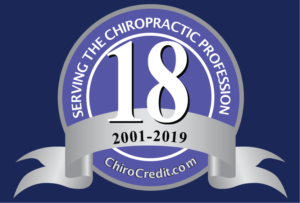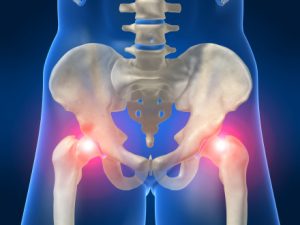 Chiropractic care holds potential value for the treatment of a variety of limb conditions. For patients with osteoarthritis (OA) of the hip, a combined intervention of manual therapy provided by a chiropractor and patient education was more effective than a minimal control intervention.
Chiropractic care holds potential value for the treatment of a variety of limb conditions. For patients with osteoarthritis (OA) of the hip, a combined intervention of manual therapy provided by a chiropractor and patient education was more effective than a minimal control intervention.
A recent article by Poulsen et al (2013) contributes to our understanding of the literature regarding chiropractic and lower extremity conditions – particularly hip osteoarthritis. Hip osteoarthritis (OA) is a common joint disease and when symptomatic can have significant impact on regular daily activities. Recently, hip OA has been linked to higher mortality rates. In end stage hip OA, joint replacement surgery is an appropriate and cost-effective treatment but a long-term cohort study has documented that only 20% of patients with radiographic hip OA have had surgery 11-28 years after the initial diagnosis. Therefore, non-surgical interventions with documented effectiveness become essential for patients who do not need, or choose not to have surgery.
Although guidelines recommend patient education (PE) programs as a core intervention, systematic reviews are contradictory in conclusions regarding their effectiveness on pain and function in hip OA. Manual therapy (MT) has been proposed as an adjunct intervention to exercise for patients with hip OA but evidence is based on a single randomized clinical trial (RCT). The authors of the current study realized this gap in the literature and decided to investigate the effectiveness of a patient education (PE) program with or without the added effect of manual therapy (MT) compared to a minimal control intervention (MCI).
The design of this study was a single-center proof-of-principle three-arm parallel group RCT. Inclusion criteria were: Unilateral hip pain >3 months’ duration, age 40-80 years, radiographic hip OA defined as minimal joint space width (JSW) measurement <2.00 mm or a side difference in minimal JSW >10%, and, ability to speak and read Danish. The study took place at the Department of Orthopaedic Surgery and Traumatology, Odense University Hospital, Denmark.
During the first 2 months of recruitment, 3 exclusion criteria were added to the original criteria: patients who had had MT within the previous twelve months; patients who rated their pain severity as 1 or 2 on the numerical rating scale (NRS); patients with polyarthritis.
The 3 groups in the study were: 1) MCI; 2) PE; 3) PE + MT.
For the MCI group, a nurse provided written advice on a home stretching program derived from the PE program together with 5-10-min instruction.
The PE group, originally termed ‘Hip School’ was taught by a physiotherapist with 11 years experience. The PE program included two individual sessions and three group sessions.
In the combined PE and MT group, manual therapy was administered by a chiropractor with 20 years of clinical experience. MT was scheduled twice a week for the 6-week intervention period and treatment was individualized to each patient depending on examination findings. MT consisted of: trigger point release therapy (TPPR), muscular stretching by muscle energy technique (MET) and joint manipulation.
The primary outcome was pain severity rated on an 11-box NRS, measured after 6 weeks of intervention. Patients were asked to rate the worst pain experienced during the previous week. Secondary outcome measures were the Hip Disability and Osteoarthritis Outcome Score (HOOS) ranging from 0-100, worst to best; patients’ perceived global effect of interventions, percentage in each group having classified themselves as improved; passive hip range of motion (ROM); use of pain medication at 12 months and hip replacement surgery within the 12 month follow-up period.
Results:
- A total of 111 patients were included in the analyses at the primary end point at 6 weeks
- In the combined group (PE + MT), a clinically relevant reduction in pain severity compared to the MCI of 1.90 points was achieved
- Effect size (Cohen’s d) for the PE + MT minus the MCI was 0.92 (large effect)
- The number of patients in each group experiencing pain reduction of at least 25% from baseline to 6 weeks was PE = 8, PE +MT = 21 and MCI = 7
- Number needed to treat for PE + MT was 3
- No difference was found between the PE and MCI groups
- At 12 months, not including patients receiving hip surgery the statistically significant difference favoring PE + MT was maintained
- All HOOS (pain, symptoms, ADLs, Sport/Rec, QOL) subscales demonstrated clinically relevant and statistically significant superiority, p < 0.05 for the PE + MT group when compared to the MCI group
- Mean differences between PE and MCI were small (range 4 to 1) and not statistically significant, p > 0.05
- Effect sizes for HOOS subscales for PE + MT minus MCI ranged between 0.75 and 1.08
- No changes in hip ROM noted between groups
Key Findings:
- For primary care patients with OA of the hip, a combined intervention of manual therapy provided by a chiropractor and patient education was more effective than a minimal control intervention
- Note that patient education alone was not superior to the minimal control intervention
So, what does this study tell us? This trial demonstrated clinical and statistically significant improvements in pain, symptoms and disability for a combined intervention consisting of manual therapy provided by a chiropractor and patient education when compared to a minimal control intervention including home stretching.
Reference: Poulsen E, Hartvigsen J, Christensen HW, Roos EM, Vach W, Overgaard S. Patient education with or without manual therapy compared to a control group in patients with osteoarthritis of the hip. A proof-of-principle three-arm parallel group randomized clinical trial. Osteoarthritis Cartilage. 2013 Oct;21(10):1494-503.

 Over the last decade, research has demonstrated that spinal manipulation can change various aspects of nervous system function, including muscle reflexes, cognitive processing, reaction time, and the speed at which the brain processes information. One research group from New Zealand (Haavik et al) has hypothesized that the joint dysfunction part of the chiropractic clinical construct, the vertebral subluxation, results in altered afferent input to the central nervous system (CNS) that modifies the way in which the CNS processes and integrates all subsequent sensory input. This processing (i.e., sensorimotor integration) is a central nervous system (CNS) function that appears most vulnerable to altered inputs.
Over the last decade, research has demonstrated that spinal manipulation can change various aspects of nervous system function, including muscle reflexes, cognitive processing, reaction time, and the speed at which the brain processes information. One research group from New Zealand (Haavik et al) has hypothesized that the joint dysfunction part of the chiropractic clinical construct, the vertebral subluxation, results in altered afferent input to the central nervous system (CNS) that modifies the way in which the CNS processes and integrates all subsequent sensory input. This processing (i.e., sensorimotor integration) is a central nervous system (CNS) function that appears most vulnerable to altered inputs. We’re not ‘just treating’ back and neck pain! We are reducing the leading global burden of disease! Low back pain
We’re not ‘just treating’ back and neck pain! We are reducing the leading global burden of disease! Low back pain 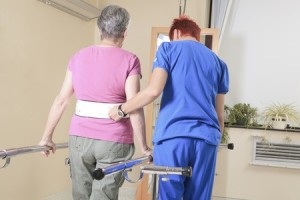 Dizziness
Dizziness A recent study incorporated a clinic of midwives and chiropractors to care for suboptimal feeding through a multidisciplinary approach. Suboptimal breastfeeding is a recognized problem among mothers and health care professionals worldwide. The aim was to assess the impact of care and education on breastfeeding and maternal satisfaction after attending the multidisciplinary clinic. On follow-up, 93% of mothers reported an improvement in feeding as well as satisfaction with the care provided. Prior to treatment, 26% of the infants were exclusively breastfed. At the follow-up survey, 86% of mothers reported exclusive breastfeeding. The relative risk ratio for exclusive breastfeeding after attending the multidisciplinary clinic was 3.6 The results from this study demonstrate high maternal satisfaction and improved breastfeeding rates associated with attending the chiropractic and midwifery clinic.
A recent study incorporated a clinic of midwives and chiropractors to care for suboptimal feeding through a multidisciplinary approach. Suboptimal breastfeeding is a recognized problem among mothers and health care professionals worldwide. The aim was to assess the impact of care and education on breastfeeding and maternal satisfaction after attending the multidisciplinary clinic. On follow-up, 93% of mothers reported an improvement in feeding as well as satisfaction with the care provided. Prior to treatment, 26% of the infants were exclusively breastfed. At the follow-up survey, 86% of mothers reported exclusive breastfeeding. The relative risk ratio for exclusive breastfeeding after attending the multidisciplinary clinic was 3.6 The results from this study demonstrate high maternal satisfaction and improved breastfeeding rates associated with attending the chiropractic and midwifery clinic.

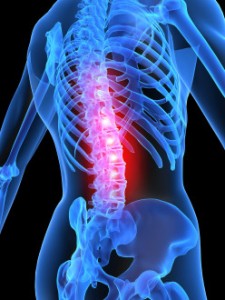
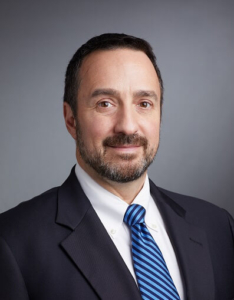 In this episode, Dr. Anthony Lisi and I discuss the state of chiropractic practice and research in the US Veterans Health Administration. Dr. Anthony Lisi is the Chiropractic Program Director for the US Veterans Health Administration, overseeing all national programmatic issues related to the integration of chiropractic clinical services, education and research. He is also an Associate Research Scientist at the Yale Center for Medical Informatics, Yale University School of Medicine.
In this episode, Dr. Anthony Lisi and I discuss the state of chiropractic practice and research in the US Veterans Health Administration. Dr. Anthony Lisi is the Chiropractic Program Director for the US Veterans Health Administration, overseeing all national programmatic issues related to the integration of chiropractic clinical services, education and research. He is also an Associate Research Scientist at the Yale Center for Medical Informatics, Yale University School of Medicine. Geoffrey Bove, DC, PhD, and I discuss his research regarding inflammation within peripheral nerves, chiropractic principles, manual therapies, repetitive motion disorders and much more. Dr. Bove is a graduate of Hampshire College, Canadian Memorial Chiropractic College, and the University of North Carolina, Chapel Hill. He is currently a professor at the University of New England, in Biddeford Maine (USA). Dr. Bove’s research has focused on the effect of inflammation on small diameter axons within peripheral nerves, a topic directed by founding chiropractic principles. He also studies the effects of manual therapies on common painful conditions, such as repetitive motion disorders and postoperative visceral adhesions.
Geoffrey Bove, DC, PhD, and I discuss his research regarding inflammation within peripheral nerves, chiropractic principles, manual therapies, repetitive motion disorders and much more. Dr. Bove is a graduate of Hampshire College, Canadian Memorial Chiropractic College, and the University of North Carolina, Chapel Hill. He is currently a professor at the University of New England, in Biddeford Maine (USA). Dr. Bove’s research has focused on the effect of inflammation on small diameter axons within peripheral nerves, a topic directed by founding chiropractic principles. He also studies the effects of manual therapies on common painful conditions, such as repetitive motion disorders and postoperative visceral adhesions.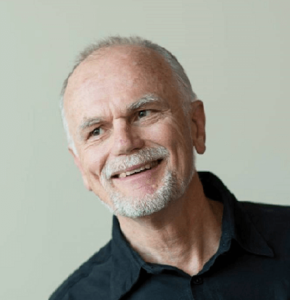


 Ian Coulter, PhD, is a senior health policy analyst at the RAND Corporation, where he holds the Samueli Institute Chair in Policy for Integrative Medicine. He is a full professor in the School of Dentistry, UCLA, in the Division of Public Health and Community Dentistry; a professor at the Pardee RAND Graduate School; and a research professor at the Southern California University of Health Sciences.
Ian Coulter, PhD, is a senior health policy analyst at the RAND Corporation, where he holds the Samueli Institute Chair in Policy for Integrative Medicine. He is a full professor in the School of Dentistry, UCLA, in the Division of Public Health and Community Dentistry; a professor at the Pardee RAND Graduate School; and a research professor at the Southern California University of Health Sciences. Join Dr. John Mayer and I as we discuss his extensive clinical and research experience in therapeutic exercise, wellness, chiropractic and first responders. John M. Mayer, DC, PhD, CCRP, FACSM is the Lincoln Endowed Chair in Biomechanical & Chiropractic Research, Executive Director of the Center for Neuromusculoskeletal Research, and Professor of the School of Physical Therapy & Rehabilitation Sciences, Morsani College of Medicine, University of South Florida. He is Director of Research and Innovation for U.S. Spine & Sport Foundation, Chief Scientific Officer of Excellcior LLC, and Co-Founder of Pillar of Health LLC
Join Dr. John Mayer and I as we discuss his extensive clinical and research experience in therapeutic exercise, wellness, chiropractic and first responders. John M. Mayer, DC, PhD, CCRP, FACSM is the Lincoln Endowed Chair in Biomechanical & Chiropractic Research, Executive Director of the Center for Neuromusculoskeletal Research, and Professor of the School of Physical Therapy & Rehabilitation Sciences, Morsani College of Medicine, University of South Florida. He is Director of Research and Innovation for U.S. Spine & Sport Foundation, Chief Scientific Officer of Excellcior LLC, and Co-Founder of Pillar of Health LLC Join Dr. Kongsted and I as we discuss her unique role as an author of the recent groundbreaking Lancet series of articles on Low Back Pain as well as many other topics. Alice Kongsted, DC, PhD graduated from the University of Southern Denmark in 1999 and completed her PhD at the Faculty of Health Sciences at the University of Southern Denmark in 2005. Up till 2009 she had clinical work as a chiropractor alongside her academic work, mainly in an outpatient hospital department. Currently she holds a position as senior researcher at the Nordic Institute of Chiropractic and Clinical Biomechanics (NIKKB) and a position as Associate Professor at the Department of Sports Science and Clinical Biomechanics at University of Southern Denmark. At NIKKB she has set up a network of chiropractic primary care research clinics that regularly participates in data collection for research purposes, the data being made available to researchers both inside and outside NIKKB. Her research interests concern spinal pain with a focus on primary care. This includes investigating the prognosis of spinal pain and why people have different outcomes.
Join Dr. Kongsted and I as we discuss her unique role as an author of the recent groundbreaking Lancet series of articles on Low Back Pain as well as many other topics. Alice Kongsted, DC, PhD graduated from the University of Southern Denmark in 1999 and completed her PhD at the Faculty of Health Sciences at the University of Southern Denmark in 2005. Up till 2009 she had clinical work as a chiropractor alongside her academic work, mainly in an outpatient hospital department. Currently she holds a position as senior researcher at the Nordic Institute of Chiropractic and Clinical Biomechanics (NIKKB) and a position as Associate Professor at the Department of Sports Science and Clinical Biomechanics at University of Southern Denmark. At NIKKB she has set up a network of chiropractic primary care research clinics that regularly participates in data collection for research purposes, the data being made available to researchers both inside and outside NIKKB. Her research interests concern spinal pain with a focus on primary care. This includes investigating the prognosis of spinal pain and why people have different outcomes. Dr. Carolina Kolberg and I discuss her research dealing with the effect of chiropractic care on oxidative stress blood markers. Dr. Kolberg has a degree in chiropractic from the Anhembi Morumbi University in São Paulo, Brazil (2004), and she completed her Masters (2009) and PhD (2013) in Biological Sciences: Physiology at the Federal University of Rio Grande do Sul (UFRGS). Her research interests include the neurophysiology of pain and physiological effects of chiropractic treatment. Dr. Kolberg’s thesis on oxidative stress blood markers in patients with chronic back or neck pain treated with high-velocity and low-amplitude manipulation support the hypothesis that HVLA spinal manipulation leads to an antioxidant effect which, in turn, could be related to the analgesic response. Being the first chiropractor graduated in Brazil with a PhD, her goal is to promote the interest of Brazilians’ young chiropractors in research.
Dr. Carolina Kolberg and I discuss her research dealing with the effect of chiropractic care on oxidative stress blood markers. Dr. Kolberg has a degree in chiropractic from the Anhembi Morumbi University in São Paulo, Brazil (2004), and she completed her Masters (2009) and PhD (2013) in Biological Sciences: Physiology at the Federal University of Rio Grande do Sul (UFRGS). Her research interests include the neurophysiology of pain and physiological effects of chiropractic treatment. Dr. Kolberg’s thesis on oxidative stress blood markers in patients with chronic back or neck pain treated with high-velocity and low-amplitude manipulation support the hypothesis that HVLA spinal manipulation leads to an antioxidant effect which, in turn, could be related to the analgesic response. Being the first chiropractor graduated in Brazil with a PhD, her goal is to promote the interest of Brazilians’ young chiropractors in research. Dr. Craig Moore discusses the role of chiropractors in the management of headaches. Some areas of discussion we touch upon include the societal impact and costs associated with headaches; prevalence of headaches in the community; prevalence of headache in chiropractic clinical settings; why do people turn to chiropractors; current level of evidence for chiropractic treatment of different headache types; what do the headache guidelines recommend for each headache; what should a chiropractor consider when examining a headache patient (history and examination).
Dr. Craig Moore discusses the role of chiropractors in the management of headaches. Some areas of discussion we touch upon include the societal impact and costs associated with headaches; prevalence of headaches in the community; prevalence of headache in chiropractic clinical settings; why do people turn to chiropractors; current level of evidence for chiropractic treatment of different headache types; what do the headache guidelines recommend for each headache; what should a chiropractor consider when examining a headache patient (history and examination).